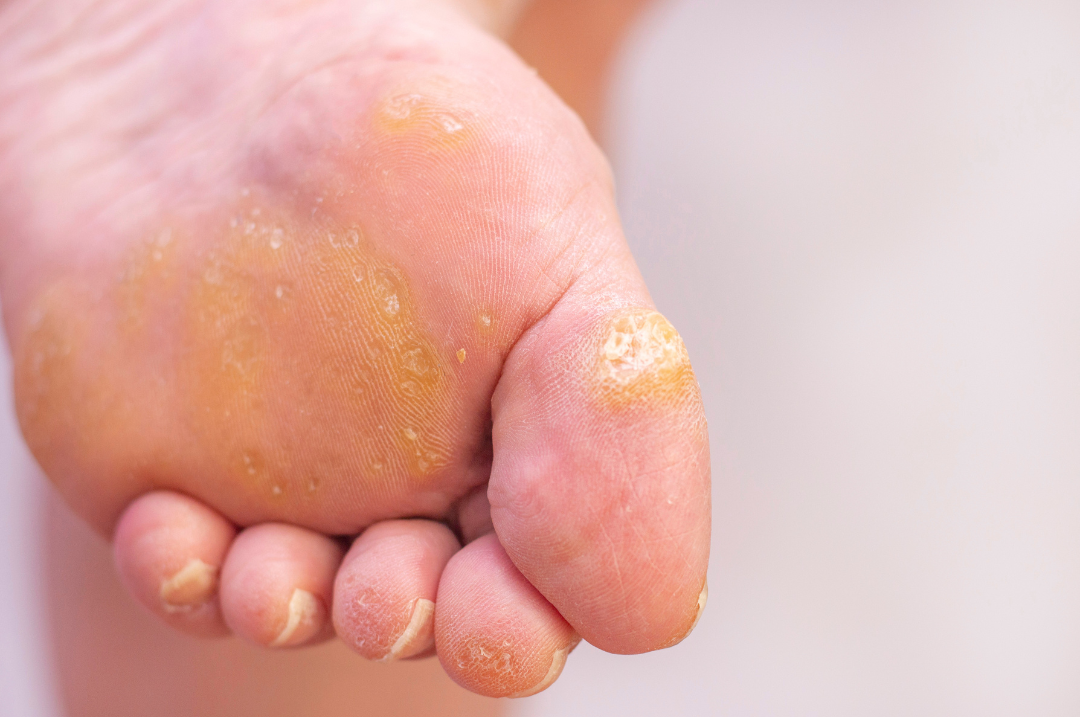Is It An Ingrown Nail, Or A Corn? A Case Study
December 20, 2022

While most of the time our patients are confident about an ingrown toenail diagnosis, we thought we’d share the case of a recent patient who thought she had a very painful ingrown toenail – only to discover that she actually had a corn in the area where an ingrown toenail would normally be found.
The Symptoms
Jess* has had several ingrown toenails in the past, treated by another provider, prior to coming to see us, so she knew the symptoms she was looking out for. Aside from knowing that her work shoes that she spent 8-10 hours in per day weren’t there best for her feet and made her toes feel cramped, she also experienced:- Pain and tenderness at one edge of her right big toenail
- Redness that was isolated to one side of the toenail
- Mild swelling around the area
- Pain when pushing down on the side of the nail from the toe
What Was Found
During Jess’ exam with our podiatrist, we uncovered that she didn’t actually have an ingrown toenail. The ridge that her toenail naturally followed as it grew out (on the painful side of the nail) looked like it had been rubbing against the skin (likely contributed to by her footwear) and it had actually formed a small, hard corn down the side of the nail. As corns are firm, dead skin that often blend into the appearance of the surrounding skin, Jess never even saw it until we pointed it out. The thing with corns – and you’ll know if you’ve had one in the past – is that despite their small size, they can be incredibly painful. When present on the bottom of the foot, many of our patients describe them as constantly walking on a painful pebble. All her symptoms made sense – especially if the nail kept pressing against the corn, leading to her pain and redness.Treatment
The best part for Jess was that her treatment was very simple and straightforward. All we had to do was use a fine surgical scalpel to remove the corn – a procedure that is painless given that corns do not have any living tissue. Once the corn was removed and the toenail was no longer pressing against anything, she felt immediate relief, and was completely pain-free by the following evening.Did She Have Ingrown Toenails Previously?
The biggest question that was left for us is whether Jess really did have ingrown toenails in the same spot previously, or if she had had that corn for quite some time and it was misdiagnosed as an ingrown toenail given the symptoms were the same. As she previously had a small part of the nail removed to relieve her symptoms, it would make sense that once the part of the nail that would otherwise rub against the corn was removed, that her symptoms would stop too, so it would appear that her ingrown nail was ‘treated’ – without ever treating the true cause of her problem, meaning that it would be bound to continue recurring as the nail grew out. Interestingly, that’s something that’s almost impossible to determine now – but what we do know is that Jess won’t be having any more pain related to that particular corn.Ingrown Toenail Facts
- Aside from wearing shoes that are too tight or narrow, the biggest cause of ingrown toenails that we see and treat is a person’s nail-trimming technique – especially if they pick at or pull of the nail
- Ingrown toenails do not usually get better without treatment – a true ingrown toenail means that part of a toenail has embedded itself down in the skin of your toe (like a sharp dagger) and it must be removed
- You don’t have to suffer with repeated ingrown nails – permanent treatments that get rid of the issue once and for all are available. This involves removing a small section of the nail and then applying a chemical that destroys the nail growing cells so they don’t grow back.
- We see just as many children (often adolescents) with ingrown nails as adults. We have also successfully treated ingrown nails on young toddlers. They can occur at any age
- Having an ingrown nail where the nail has pierced your skin means that you are vulnerable to infection as long as the nail is in there and you have an open wound.
